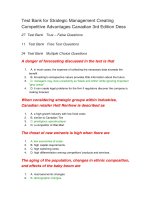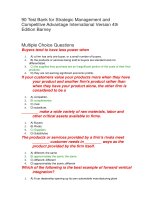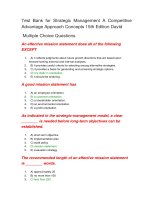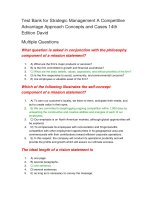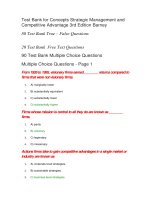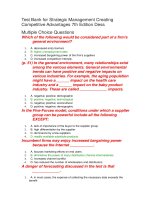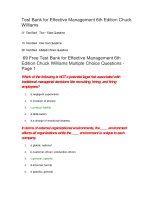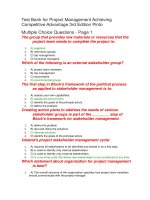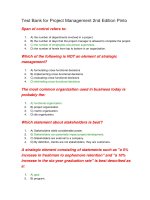105 test bank for project management achieving competitive advantage 3rd edition pinto
Bạn đang xem bản rút gọn của tài liệu. Xem và tải ngay bản đầy đủ của tài liệu tại đây (134.52 KB, 21 trang )
Test Bank for Project Management Achieving
Competitive Advantage 3rd Edition Pinto
Multiple Choice Questions - Page 1
The group that provides raw materials or resources that the
project team needs to complete the project is:
1.
2.
3.
4.
A) suppliers.
B) intervenor groups.
C) top management.
D) functional managers.
Which of the following is an external stakeholder group?
1.
2.
3.
4.
A) project team members
B) top management
C) accountants
D) environmental groups
The first step in Block's framework of the political process
as applied to stakeholder management is to:
1.
2.
3.
4.
A) assess your own capabilities.
B) assess the environment.
C) identify the goals of the principal actors.
D) define the problem.
Creating action plans to address the needs of various
stakeholder groups is part of the ________ step of
Block's framework for stakeholder management.
1.
2.
3.
4.
A) define the problem
B) test and refine the solutions
C) develop solutions
D) identify the goals of the principal actors
Cleland's project stakeholder management cycle:
1.
2.
3.
4.
A) requires all stakeholders to be identified and locked in as a first step.
B) is used to identify only internal stakeholders.
C) is used to identify only external stakeholders.
D) is a recurring cycle that allows new stakeholders to be considered at any time.
Which statement about organization for project management
is best?
1.
A) The overall structure of the organization specifies how project team members
should communicate with the project manager.
2.
B) The internal project team structure specifies the arrangement of all units or
interest groups participating in the development of the project.
3. C) Two distinct organizational structures operate simultaneously within the project
management context: the organizational structure and the project team structure.
4. D) All of these statements are correct.
External stakeholders that are external to a project but
possess the power to effectively disrupt the project's
development are:
1.
2.
3.
4.
A) intervenor groups.
B) environmental groups.
C) stressor groups.
D) special-interest groups.
A strategic element consisting of statements such as "a 5%
increase in freshman to sophomore retention" and "a
10% increase in the six-year graduation rate" is best
described as a:
1.
2.
3.
4.
A) goal.
B) program.
C) strategy.
D) mission.
All major decisions and authority are under the control of the
project manager in a:
1.
2.
3.
4.
A) matrix structure.
B) functional structure.
C) project structure.
D) process structure.
Which of the following is NOT an element of organizational
structure?
1.
2.
3.
4.
A) well-articulated mission, vision, and value statements
B) formal reporting relationships
C) grouping together of individuals into departments
D) systems designed to ensure effective communication
Span of control refers to:
1.
2.
3.
4.
A) the number of departments involved in a project.
B) the number of days that the project manager is allowed to complete the project.
C) the number of employees one person supervises.
D) the number of levels from top to bottom in an organization.
The functional structure is well-suited when:
1.
A) there are low levels of external uncertainty.
2.
3.
4.
B) there is high instability in the environment.
C) project coordination is assigned to the lowest levels in an organization.
D) there must be rapid response to external opportunities and threats.
A functional organization structure is a plus for project
management because:
1.
2.
3.
4.
A) functional siloing often exists.
B) it allows for standard career paths.
C) there is high customer focus.
D) commitment to project success is high and unwavering.
The management department at the university decides to
add a new program in restaurant, hotel, and
institutional management. As part of the development
process they hold focus groups consisting of area
business leaders, current and former students, and
restaurant and hotel owners. These groups can be
described as:
1.
2.
3.
4.
A) project leaders.
B) project workers.
C) stakeholders.
D) clients.
Economic conditions are a part of an organization's:
1.
2.
3.
4.
A) external environment.
B) stakeholders.
C) organizational hierarchy.
D) organizational structure.
A functional organization structure is a weakness for project
management because:
1.
2.
A) in-depth knowledge and intellectual capital development are enabled.
B) no disruption or changes to a firm's design are necessitated by projects
developed within this structure.
3. C) priorities among functional departments may be different and competing.
4. D) standard career paths are enabled so team members only perform their duties
as needed.
A strategic perspective on project management might ask
which of the following questions prior to undertaking a
project?
1.
2.
3.
A) What is our corporate culture?
B) Does this project support the company vision?
C) Do we have the necessary budget for this project?
4.
D) Can we define the problem?
Which of the following is NOT an element of strategic
management?
1.
2.
3.
4.
A) formulating cross-functional decisions
B) implementing cross-functional decisions
C) evaluating cross-functional decisions
D) eliminating cross-functional decisions
The tendency of employees in a functionally organized
company to become fixated on their own concerns and
work assignments to the exclusion of the needs of
other departments is known as:
1.
2.
3.
4.
A) layering.
B) myopia.
C) nepotism.
D) siloing.
Individuals are commonly organized into departments for all
of the following reasons EXCEPT:
1.
2.
3.
4.
A) seniority.
B) function.
C) product.
D) geography.
A major player in the software industry stumbles from one
new edition of its operating system and office
automation package to another. As soon as one
package is released, the programmers and developers
have two weeks to latch onto a different team that is
updating a different package. Failure to find another
team to work for means an end to their employment.
This organizational structure is best classified as a:
1.
2.
3.
4.
A) functional organization.
B) matrix organization
C) project organization.
D) flexible organization.
Companies that are structured by grouping people
performing similar activities into departments are:
1.
2.
3.
A) project organizations.
B) functional organizations.
C) matrix organizations
4.
D) departmental organizations.
Which of the following is an internal project stakeholder
group?
1.
2.
3.
4.
A) clients
B) suppliers
C) functional managers
D) competitors
A strategic element that contains formally titled initiatives
such as the Customer Survey Project, the Small
Business Alliance Project, and the Employee Relations
Project is most likely a:
1.
2.
3.
4.
A) mission.
B) strategy.
C) goal.
D) program.
Which of the following statements about clients is best?
1.
2.
A) Client refers to the entire customer organization.
B) Clients are concerned with receiving the project as quickly as they can possibly
get it.
3. C) Client groups tend to have similar agendas.
4. D) A single presentation is best when dealing with all client groups in an
organization so that everyone hears exactly the same message.
The University of Puhonicks hires several professors that
specialize in accounting, management, and economics
and clusters each into one of three departments. The
dean has obviously decided to group employees by:
1.
2.
3.
4.
A) function.
B) geography.
C) project.
D) product.
In general, the poorest organizational structure when it
comes to managing projects is probably the:
1.
2.
3.
4.
A) matrix structure.
B) functional structure.
C) project structure.
D) process structure.
Organizational structure identifies the grouping of
individuals into:
1.
2.
3.
4.
A) organizations.
B) companies.
C) silos.
D) departments.
Which statement about stakeholders is best?
1.
2.
3.
4.
A) Stakeholders wield considerable power.
B) Stakeholders can potentially impact project development.
C) Stakeholders are external to a company.
D) By definition, clients are not stakeholders, they are customers.
The highest priority among strategic choice elements is:
1.
2.
3.
4.
A) objective.
B) strategy.
C) mission.
D) goal.
Probably the most common type of organizational structure
today is:
1.
2.
3.
4.
A) project.
B) functional.
C) matrix.
D) organic.
Which of these strategic elements exists at a higher level
than the others?
1.
2.
3.
4.
A) programs
B) objectives
C) goals
D) strategies
John Drone toils endlessly at Hurts Corporation on his
routine assignment and also on a number of project
teams. His annual evaluation features input from his
line manager and each of the project managers, all of
whom have equal say in how his 12-hour work day is
partitioned. John Drone is employed by a:
1.
2.
3.
4.
A) functional organization.
B) project organization.
C) cross-functional organization.
D) matrix organization.
64 Free Test Bank for Project Management Achieving
Competitive Advantage 3rd Edition Pinto Multiple
Choice Questions - Page 2
The tale of Professor Larry Foster and his grade book filled
with Fs was told by one generation of faculty to the
next with a mix of envy, awe and delight. If there was
one thing you could be sure of, there was no grade
inflation in his department, whose culture was formed
primarily by:
1.
2.
3.
4.
A) critical incident.
B) reward system.
C) rules and procedures.
D) environment.
Staffing fluctuations associated with project completion and
initiation are most likely to occur in organizations that
are:
1.
2.
3.
4.
A) functionally structured.
B) project structured.
C) matrix structured.
D) process structured.
When grades aren't submitted in a timely fashion, the course
management system assigns an incomplete. When a
graduating student receives an incomplete in a senior
level course, his job offer is withdrawn. When his job
offer is withdrawn, the student has to crash at his
buddy's apartment. When a student crashes at his
buddy's apartment, he has to sleep on the couch.
When a student sleeps on the couch, he wakes up
covered with cat hair. In an effort to keep students free
from cat hair, college leadership dema
1.
2.
3.
4.
A) reward systems.
B) rules and procedures.
C) key organizational members.
D) environment.
The PMO is used to protect and support the skill of project
management under the:
1.
A) resource pool model.
2.
3.
4.
B) weather station model.
C) control tower model.
D) project model.
The project manager controls most of the project activities
and functions, including the assignment and control of
project resources in the:
1.
2.
3.
4.
A) strong matrix.
B) weak matrix.
C) dual matrix.
D) primal matrix.
Believe it or not, project structures have weaknesses when it
comes to project management! One of the primary
weaknesses has to do with:
1.
2.
3.
4.
A) rapid response to market opportunities.
B) communication across the organization and among functional groups.
C) effective and speedy decision making.
D) the low cost of setting up and maintaining project teams.
The Luther Post Office closes the customer service window
promptly at noon for their lunch break and opens
again at one, perhaps a little after if the town's Sonic is
busy. The Jones Post Office workers are aghast at this
policy, preferring to stagger their lunch breaks so that
the customer service window is always attended. It
would appear that this difference in culture is primarily
driven by:
1.
2.
3.
4.
A) reward systems.
B) key organizational members.
C) critical incidents.
D) geographical location.
The Larson and Gobeli study that compared projects that
had been managed in a variety of structural types
revealed that new product development projects
tended to be most effectively executed when the
organizational structure was a:
1.
2.
3.
4.
A) project matrix.
B) project organization.
C) balanced matrix.
D) functional matrix.
The PMO is used as a tracking and monitoring device under
the:
1.
2.
3.
4.
A) control tower model.
B) resource pool model.
C) weather station model.
D) radar model.
A matrix organization for project management has a distinct
advantage because:
1.
2.
A) dual hierarchies mean two bosses.
B) a significant amount of time is spent negotiating the sharing of critical
resources.
3. C) workers must reconcile competing project and functional demands.
4. D) project importance is enhanced by setting authority equal to that of functional
departments.
The Larson and Gobeli study that compared projects that
had been managed in a variety of structural types
revealed that construction projects tended to be most
effectively executed when the organizational structure
was a:
1.
2.
3.
4.
A) project organization.
B) balanced matrix.
C) project matrix.
D) functional matrix.
The manager of the Super Burrito Project is in the midst of
an important project team meeting but Fred Fromage,
the representative from the Cheese department, is
nowhere to be found. After a brief investigation it is
determined that Fred's manager in the Cheese
department has other plans for Fred's time and efforts
over the next several days and he simply won't be
available for Super Burrito Project work. The
organizational structure being used here is
unquestionably a:
1.
2.
3.
4.
A) strong matrix.
B) weak matrix.
C) project organization.
D) chevre organization.
Centralized units within an organization or department that
oversee or improve the management of projects are
called:
1.
2.
3.
4.
A) project management offices.
B) PERT units.
C) tiger teams.
D) central clearinghouses.
The Larson and Gobeli study that compared projects that
had been managed in a variety of structural types
revealed that both new product development and
construction projects tended to be least effectively
executed when the organizational structure was a:
1.
2.
3.
4.
A) project matrix.
B) project organization.
C) balanced matrix.
D) functional organization.
The belief that organizations can sometimes gain
tremendous benefit from creating a fully dedicated
project organization is captured by the term:
1.
2.
3.
4.
A) heavyweight project organization.
B) matrix organization.
C) benevolent society.
D) leveraged benefits.
A dual hierarchy is the salient feature of a:
1.
2.
3.
4.
A) project structure.
B) matrix structure.
C) functional structure.
D) bi-modal structure.
Herb Kelleher of Southwest Airlines frequently takes
Southwest flights to check out operations and
informally interview passengers to find out how
satisfied they are with their service. Herb's attention to
customer service and emphasis of it over profits
permeates the organization. Southwest's corporate
culture is influenced strongly by:
1.
2.
3.
A) reward systems.
B) rules and procedures.
C) key organizational members.
4.
D) environment.
The greatest advantage of a PMO is that:
1.
2.
3.
4.
A) it is essentially another layer of oversight within the organization.
B) it helps an organization develop project management skills.
C) it serves as a bottleneck for communication across the organization.
D) all project management skills are located at one point in an organization.
The information systems department prides itself on being
on the often bleeding edge of high-tech course
offerings. They were the first department to create
online classes and the first to battle all of the issues
associated with these offerings. When Wally
interviewed for the new assistant professor position,
he knew that his subcutaneous chip was only a hiring
decision away. Corporate culture in this department is
probably most affected by:
1.
2.
3.
4.
A) the environment.
B) technology.
C) geographical location.
D) critical incidents.
A PMO is NOT used:
1.
2.
3.
4.
A) as a resource center.
B) to act as a central repository for project documentation.
C) to replace the project manager as being responsible for the project.
D) as the place where project management improvements are identified and then
disseminated to the rest of the organization.
Which of the following statements about culture is best?
1.
A) Rules of behavior are formally written down so they can be learned as quickly
as possible.
2. B) Rules of behavior are common across the entire organization regardless of how
large it is.
3. C) Rules of behavior, since they are informal, may be accepted or rejected by new
employees in the organization.
4. D) The conversion process a company uses can influence its culture.
The strong matrix is also known as the:
1.
2.
3.
4.
A) functional matrix.
B) primal matrix.
C) dual matrix.
D) project matrix.
One way that organizational culture affects project
management is by:
1.
2.
3.
4.
A) how the environment is affected by the culture.
B) where the project occurs and how much it ultimately costs.
C) the level of resources needed to complete the project.
D) how departments are expected to interact with each other.
The weather station model performs the invaluable function
of:
1.
2.
3.
4.
A) keeping an eye on project status without influencing the project.
B) establishing standards for managing projects.
C) enforcing the adherence to accepted protocols for project management.
D) improving the current state of project management procedures.
The PMO is used to maintain and provide a cadre of skilled
and trained project professionals as needed under
the:
1.
2.
3.
4.
A) control tower model.
B) cadre model.
C) weather station model.
D) resource pool model.
Which of the following does NOT constitute an impact of
organizational culture on project management?
1.
2.
3.
4.
A) the way departments interact with each other
B) how much trust exists among project team members
C) how customers perceive mission and vision
D) how committed employees are to goals
A failing project becomes a black hole for money, time, and
personnel as management continues to pour
resources into it despite the growing expectation that
it will fail miserably. This phenomenon is known in
project management circles as:
1.
2.
3.
4.
A) the vanishing horizon.
B) the Pareto principle.
C) escalation of commitment.
D) negative outcome disposition.
The weak matrix is sometimes called the:
1.
2.
3.
A) red pill matrix.
B) project matrix.
C) functional matrix.
4.
D) departmental matrix.
A project structure for an organization is a peach when you
consider how well it:
1.
2.
3.
A) creates legions of project management experts.
B) maintains a pooled supply of intellectual capital.
C) assuages the fear of unemployment by project team members once the project
has ended.
4. D) fosters loyalty to the overall organization by project team members.
A major weakness of a matrix organizational structure for
project management occurs when:
1.
2.
A) the environment is dynamic.
B) resources are scarce and shared between functional responsibilities and the
competing project.
3. C) the number of human resource coordination meetings is considered.
4. D) one considers the dual importance of project management and functional
efficiency.
The solution to external and internal problems that has
worked consistently for a group and that is therefore
taught to new members as the correct way to perceive,
think about, and feel in relation to these problems is
known as:
1.
2.
3.
4.
A) groupthink.
B) socialization.
C) organizational culture.
D) a frame of reference.
True - False Questions
Suppliers and competitors are possible intervenor groups in
a project.
1.
2.
True
False
The resource pool model of the project management office
(PMO) works best when the PMO is generally viewed
as a Level 1 support structure.
1.
2.
True
False
An important step in stakeholder management is the
assessment of your own capabilities.
1.
True
2.
False
Most companies are well suited to allow for successful
completion of projects in conjunction with other
ongoing corporate activities.
1.
2.
True
False
A project management office is designed to oversee or
improve the management of projects without stripping
responsibility from the project manager.
1.
2.
True
False
One element of strategic management is cross-functional
decision making.
1.
2.
True
False
A project organization does not have functional
departments.
1.
2.
True
False
Stakeholder analysis looks at a project's customers and
determines whether their needs are being met.
1.
2.
True
False
Technology, environment, rules, and reward systems can all
contribute to a company's culture.
1.
2.
True
False
The weather station model of the project management office
(PMO) uses the PMO as only a tracking and monitoring
device.
1.
2.
True
False
Developing vision and mission statements is an important
tactical step in project management.
1.
2.
True
False
Organizational culture can be influenced a variety of ways,
including by reward systems and key organizational
members.
1.
2.
True
False
Strategy, goals, and programs support the organizational
mission.
1.
2.
True
False
Typically, organizational culture consists of formally written
rules and guidelines that members can refer to as
needed.
1.
2.
True
False
The resource pool model of the project management office
(PMO) provides skilled labor to an organization's
projects.
1.
2.
True
False
Policies and procedures are examples of an organization's
external environment.
1.
2.
True
False
The same project managed in the same fashion may succeed
in one organization but fail in another.
1.
2.
True
False
Free Text Questions
________ is the term for the tendency for employees to
become fixated on their concerns and work
assignments to the exclusion of the needs of other
departments.
Answer Given
Functional siloing
What are the essential components of corporate strategy and
how are they related?
Answer Given
The essential components of corporate strategy are mission, objectives, strategy,
goals, and programs. A hierarchical model is presented in the chapter where
mission resides at the tip of a pyramid, objectives that more formally define the
mission support it, and strategy, goals, and programs underlie the objectives.
These strategic elements must align with each other in order for an organization to
be successful long term.
What is a pure project structure for an organization? What
are the advantages of using this structure?
Answer Given
A project structure is set up such that the exclusive focus is on running projects.
Each project is a self-contained business unit with a dedicated project team. The
project manager is the leader of the project and the staff all report to the leader.
The staffing decisions and duration of the employees' tenure with the project are
left to the discretion of the project manager, who is the chief point of authority for
the project. The four advantages of this structure as presented in the text are: the
project manager is the authority and in control of the project; improved
communication among project team members; there is a ready supply of trained
project management professionals; and increased flexibility and rapid response to
environmental opportunities.
The first step in the project stakeholder management cycle is
to ________.
Answer Given
identify the stakeholders
The ________ form of the project management office has the
goal of maintaining and providing trained and skilled
project professional as they are needed.
Answer Given
resource pool
What are Block's six steps to stakeholder management and
what should be accomplished in each step?
Answer Given
Block's six steps as applied to stakeholder management include: 1) assess the
environment; 2) identify the goals of the principal actors; 3) assess your own
capabilities; 4) define the problem; 5) develop solutions; 6) test and refine the
solutions. Assessing the environment calls for an investigation into the project's
impact — will it be very high profile or low key? Identification of the principal
actors' goals is a first step in defusing negative reaction. The project team should
also look for hidden agendas in goal assessment. Assessment of your own
capabilities means taking inventory of the organization and identifying strengths
and weaknesses. Solution development means creating an action plan to address
the needs of the stakeholder groups and doing political homework. Testing and
refining the solution requires acknowledging that the project manager and team
are operating under imperfect information.
Describe the ways that individuals are grouped within an
organization.
Answer Given
The most common reasons for creating a department are by function, product,
geography, and project. Functional structures group people performing similar
activities into departments. Product structures cluster together all employees
responsible for a single product line or family of products. Geography ignores
product and function and groups people by geographical region or physical
location. Project grouping puts people involved in the same project in the same
department.
What are the three types of organizations presented by the
author and how are they different?
Answer Given
The three organizational structures presented by the author are the functional
organization, the project organization, and the matrix organization. The functional
structure is probably the most common organization and consists of grouping
people by business activity or duties in the organization. A project organization is
set up with their exclusive focus aimed at running projects. Resources are
assigned to the project for as long as the project needs them. A matrix
organization is a combination of functional and project alternatives and seeks a
balance between these two extremes. The matrix structure creates a dual
hierarchy where there is a balance of authority between project emphasis and
functional departmentalization.
Any group that provides raw materials or other resources
that the project team needs to complete the project are
________.
Answer Given
suppliers
Compare the organizational culture among the students in
this class with a contrasting student organizational
culture from another class at this or another
institution. Identify key differences in how these two
different cultures developed using factors discussed
in this book.
Answer Given
Examples will vary, but the student should identify differences stemming from the
technology, environment, geographical location, reward system, rules and
procedures, key organizational members and/or critical incidents.
What are the elements of organizational structure?
Answer Given
Organizational structure consists of three key elements. It designates formal
reporting relationships, including the number of levels in the hierarchy and the
span of control of managers and supervisors. Organizational structure identifies
the grouping together of individuals into departments and departments into the
total organization. Organizational structure includes the design of systems to
ensure effective communication, coordination, and integration of effort across
departments.
External stakeholders that are groups external to the project
but still possess the power to effectively disrupt the
project's development are ________.
Answer Given
intervenor groups
What is strategic management and what role do projects play
in it?
Answer Given
Strategic management is the science of formulating, implementing, and evaluating
cross-functional decisions that enable an organization to achieve its objectives.
Projects have been called "stepping stones" of corporate strategy because an
organization's overall strategic vision is the driving force behind its project
development. Many firms apply their vision statement or mission to evaluating new
project opportunities as a first screening device.
Compare and contrast the three types of project
management offices with regards to place in
organization, function, and effectiveness in project
management.
Answer Given
A project management office (PMO) is a centralized unit within an organization or
department that oversees or improves the management of projects. PMOs have
been described as operating under one of three alternative forms and purposes
within companies: 1) weather station, 2) control tower, and 3) resource pool. The
major difference among the three forms is the level of involvement in the project
management process. The weather station form is used only when the PMO is
needed for tracking and monitoring project progress. The control tower model
treats project management as a business skill to be protected and supported,
focusing on developing methods for continually improving project management
skills. The goal of the resource pool PMO is to maintain and provide a cadre of
trained and skilled project professionals as they are needed.
What are three ways that organizational culture impacts
project management?
Answer Given
Organizational culture may affect project management in at least four ways. First,
it affects how departments are expected to interact and support each other in
pursuit of project goals. Second, the culture influences the level of employee
commitment to the goals of the project on balance with other, potentially
competing goals. Third, the culture influences project planning processes such as
the way work is estimated or how resources are assigned to projects. Finally, the
culture affects how managers evaluate the performance of project teams and how
they view the outcomes of projects.
Describe the two forms of a matrix organization and indicate
the advantages of each for project management.
Answer Given
A matrix organization may be further classified as being a weak matrix (sometimes
called functional matrix) and a strong matrix (sometimes referred to as a project
matrix). A weak matrix has a great deal of functional organization character; the
manager still controls resources and manages project components. The strong
matrix cedes much of this control over to the project manager. If the functional and
project managers differ in skills, then the form having the superior manager would
be ideal. The strong matrix is the closest that a matrix environment can come to
be a true project organization. If the competitive environment is such that a project
organization form is ideal, then the strong matrix is superior to the weak matrix.
What is meant by the statement, "successful project
management is contextual"?
Answer Given
The author indicates that the organization itself really matters — its culture, its
structure, and its strategy each play an integral part, and together they create the
environment in which a project will flourish or founder. Contextual issues provide
the backdrop around which project activities must operate, so understanding what
is beneath these issues truly contributes to understanding how to manage
projects.
________ designates formal reporting relationships,
including the number of levels in the hierarchy and the
span of control of managers and supervisors.
Answer Given
Organizational structure
Define the term stakeholder and discuss the major groups of
stakeholders.
Answer Given
Stakeholders are defined as all individuals or groups who have an active stake in
the project and can potentially impact, either positively or negatively, its
development. Internal and external are the broad categories of stakeholder
groups. Internal stakeholders include top management, project team members,
and other functional managers, among others. External stakeholder groups
include clients, competitors, suppliers, and intervenor groups.
What are the advantages and disadvantages of using a
functional structure to manage a project?
Answer Given
A functional structure groups people and departments performing similar activities
into units. Division of labor in the functional structure is not based on the type of
product or project supported, but rather according to the type of work performed.
In an organization having a functional structure, members routinely work on
multiple projects or support multiple product lines simultaneously. The most
common weakness in a functional structure is the tendency for employees
organized this way to become fixated on their concerns and work assignments to
the exclusion of the needs of other departments (called functional siloing). An
additional weakness of the functional structure is it provides no logical location for
a central project management function and that projects operating in this
environment must be layered on top of the duties of functional groups. Finally,
there is a tendency to sub-optimize efforts on a project that is not tightly bound to
a group. A department that is not directly affected by a project may put forth only
the minimum effort.
Functional departments maintain control over their
resources and are responsible for managing their
components of the project in a(n) ________.
Answer Given
weak matrix
Define organizational culture and explain how it is
developed.
Answer Given
Organizational culture is the unwritten rules of behavior or norms that are used to
shape and guide behavior, as shared by some subset of organizational members
and is taught to all new members of the company. Organizational cultures may
form from an organization's technology, environment, and geographical location.
An organization's reward system and rules and procedures also influence the
culture. Key organizational members and critical incidents may make a strong
enough impression to help form organizational culture.
________ are all individuals or groups who can potentially
impact a project's development.
Answer Given
Project stakeholders
Describe the phenomenon called "escalation of
commitment" and where it fits in the lore of
organizational culture.
Answer Given
Escalation of commitment occurs when, in spite of evidence identifying a project
as failing, no longer necessary, beset by huge technical or other difficulties, and
just an all around bad idea, organizations continue to support it past the point
where an objective viewpoint would suggest that it should be terminated.
Escalation of commitment that is well known to an entire organization might fit
most neatly alongside such culture affecting factors as key organizational
members and critical incidents. Although there are a number of reasons for
escalation of commitment to a failed decision, one important reason is the
unwillingness of the organization to acknowledge failure or its culture working
toward blinding key decision makers to the need to take corrective action. I had a
car like this once.

